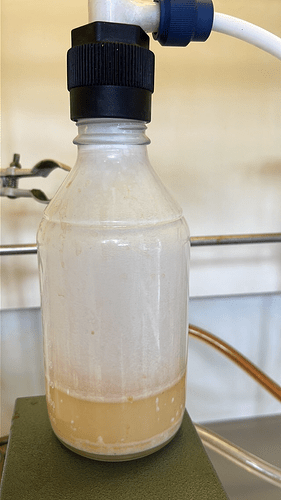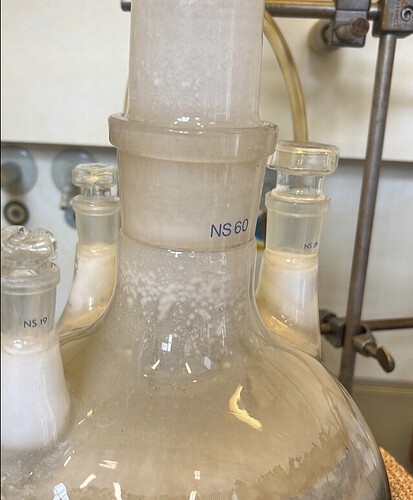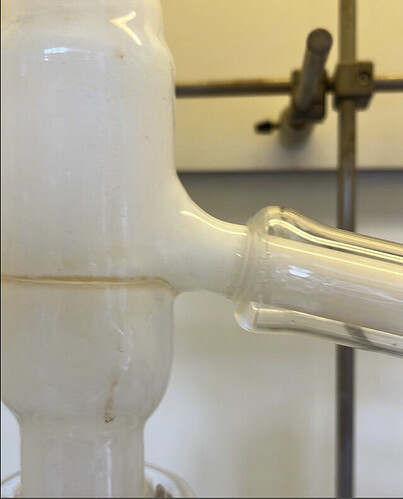Ok so made some 4h-cbd as usual
BUT with this issolate I got from Luxemburg
All went wel conversion to 4h-cbd number are as usual the GC did not pick up spikes that are awkward
But when doing the final distillation this poped up white fumes and gunk a bit prior to the normal heads at this vacuum depth and temp
Now I know fats and lipids but this stuff is barely soluble in any solvent not even tolueen alkanes alcohols yust not soluble at all in most
What is it ?? Is it a cut that’s been added to the issolate ? Anybody seen this before ?? Puzzling
Salts ? Filtration Media…
They dont Show Up on GC
But you For Sure considered this…
Maybe you can try to use DMSO to dissolve it? DMSO has a pretty good solubility for a lot of stuff. Then in solution maybe try a mass spec and look at peaks compared to a library as a start for identification? I don’t have any familiarity with the synthesis so that would be my best thought to start with.
What else was in the flask for your reduction?
Every thing as usual it s from the cbd issolate 99.9% it s mad
Dcm accitic acid pd/c and cbd
Send me the batch number that you used for it as I also had Isolate from LUX that only showed 90% in different analysis opposed to the 99.5% that was claimed.
And that was clear white.
I guess it was cut but no idea with what.
Exactly clear white to white to be right kinda white
I ll get the info ASAP
This batch was delivered by Greg DuPont from botanicalz in Luxemburg and the idiot admits having had more complaints
This shit runs treu to coldtraps and killed one of my favorit vacuum pumps
![]()
![]()
![]()
Free fatty acids or mono-and-di-glycerides are my guess. They’re the only impurity I can think of that will come along for the ride through most isolate refinement processes (dewaxing, LLE, ReX) in appreciable quantities. They also tend to distill out in the heads fraction for the heaviest ones (C18) and well before for the lighter ones (C8-12).
A way to test is dissolve a sample in heptane, pour into sep funnel and shake with 3% neutral brine (NaCl). Observe how fine the emulsion is; very fine droplets (organic layer gets very cloudy) means its likely FFA’s. Then pass heptane solution through alkaline media (MagSil or alkaline aluminum oxide). Now pour the solution back into the sep funnel and add more 3% neutral brine. If the emulsion forms big droplets (still clear after stirring) there are likely no FFAs.
I would also recommend trying a solubility/winterization test in ethanol or methanol. Dissolve in 6:1 hot alcohol, let cool to room temperature watching for flocculant. Cooling is likely a good idea as well.
Step one might be tough as he did mention it wasn’t soluble in alkanes.
Granted there are a lot of alkanes out there but if he’s doing synthesis type chemistry with cannabinoids, it’s probably a safe assumption that he has hexane and heptane readily available to him and I would assume these were the alkanes he attempted to dissolve the material in.
Exactly does not dissolve in the 2 alkanes mentioned above
Only tolueen and ethyl acetate but both discolor white milky like
This is not plant material makes me think of melamine or something
The chineese used to cut baby food some time back
The other disqualifier is this did not show up on GCMS. Perhaps take a sample of the gunk after and GCMS that? @Roguelab do you have access to a LC-MS? If it isn’t the FFA portion of waxes, perhaps the non-saponifiable portion? Vacuum grease? I’m at straws at this point for plant origin, seems unlikely because insolubility would have stopped it dead in its tracks during winterization. Not sure what your H4-CBD rxn is, but I could see vacuum grease reacting with a heavy metal catalyst to make all sorts of junk, would explain the lack of it on GCMS and grease contamination is pretty common.


